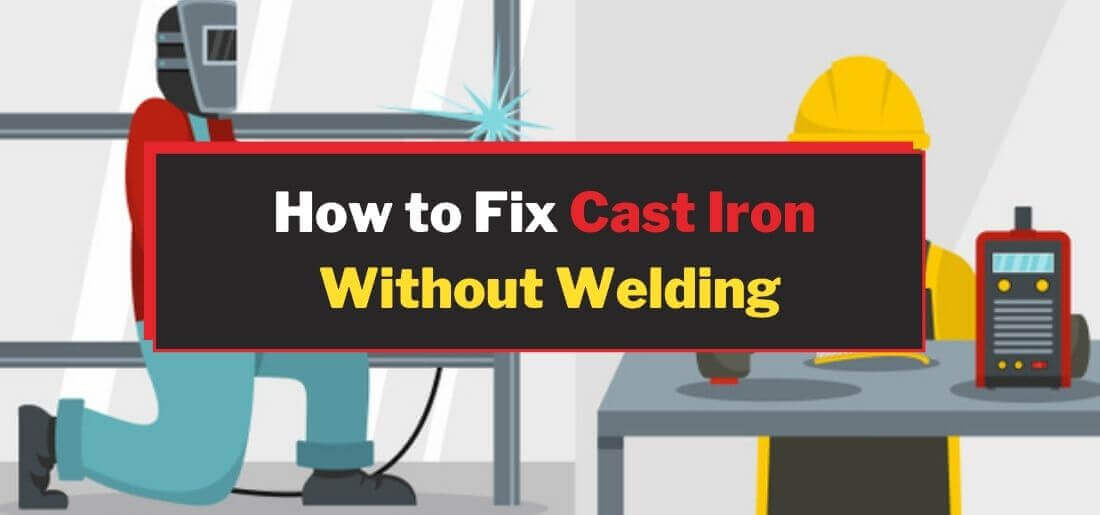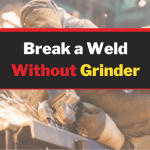Are you looking for methods to fix your cracked cast iron equipment other than welding to avoid further damage to your cast iron equipment? If yes, then we will provide full guidance to solve your problem.
Cast iron equipment is commonly used in every household and industry, as they are cheap and easy to make. The problem with cast iron is that it is brittle by its nature. Sudden changes in temperature and physical stress can cause cracks in it.
The most common method used to fix these cracks is welding, but this process uses extreme temperature, which can further damage the cast iron. To avoid this, we have assessed various methods to repair the cast iron and selected 3 of them that worked well.
Now without wasting any time, let’s jump straight into details about how you can fix cast iron without welding through these given 3 Methods!
3. Steps to Fix Cracked Cast Iron by Cold Metal Stitching
Cold metal stitching is a great and efficient way to fix cracks on cast iron, as this process doesn’t need extreme heat or stress. Moreover, cold metal stitching doesn’t damage the cast iron if done correctly.
Follow the below-mentioned steps to cold metal stitch your cracked cast iron equipment:
1) Assessing The Crack
The first step of cold metal stitching is to assess the crack on cast iron. Most of the time, the length of the crack doesn’t matter, but you have to see whether it is feasible to cold metal stitch it or cast another piece entirely. Once you have assessed the crack on cast-iron equipment, then you can go for the next step.
2) Drilling Holes Along The Crack
Now that you had decided that cold metal stitching is feasible. The next step is to drill perpendicular sets of holes along the crack. These holes should be at a specific distance from each other. If you make a different number of holes in every batch of it, it will be best.
In this way, you will create different strong points to hold the crack. Once the process of drilling holes is completed, then you can take the next step.
3) Joining The Holes
Once all holes are drilled across the crack, it’s time to join these holes; it will make it easier to insert the metal stitch used to hold the crack. For this purpose, you have to use a chisel that can join the holes without damaging the cast iron or holes. As these round shoulders of holes will hold the stitch, so it is important not to damage the diameter of the holes.
4) Inserting The Metal Stitches
Once everything is ready, you can now insert the metal stitch. Make sure that the metal stitch fits perfectly. If not, it can cause further cracks and render the whole equipment useless. Use a wooden hammer to press-fit the metal stitch. If some metal sticks out of the cast-iron surface, don’t worry; we will get rid of it in the next steps.
5) Sewing The Stitches
Using only metal stitches to fix the crack on cast iron is not a great way, as metal stitches can break due to extreme heat or pressure. To strengthen your cold metal stitching, you had to add screws between metal stitches. Place them as close as possible to each other and sew metal stitches between them. Tightening of these screws will increase the strength of metal stitchings.
6) Removing Excess Metal
As you may have noticed that some metal is sticking out from the surface of cast iron. The final step of cold metal stitching is to remove this extra metal. For this purpose, first, use a chisel to remove metal as much as you can. Then use a grinder to remove the rest of the metal. This step is necessary as it restores the shape of equipment and hides any evidence of its repair.
Related Article: How To Fill Holes In Metal Without Welding?
2. Steps To Fix The Cast Iron By Using Epoxy Putty
You can also use epoxy putty to fix cast iron cracks. Epoxy will act as glue and repair the crack quickly.
Follow these steps to perfectly fix cracks in your cast iron equipment.
1) Choosing Epoxy Putty
There are several types of epoxies available in the market. Every one of them is used to fix damages and cracks of a different material. To repair cracks in a cast iron, you have to buy epoxies like Quick Steel or JB Weld. These epoxies will work best for you.
Once you have chosen and bought an epoxy suitable for repairing cracks in cast iron, then you can take your next step.
2) Removing Paint And Rust from The Metal Surface
In this step, you have to remove rust and paint from the surface of the crack. This rust and paint can be removed by using 80-grit sandpaper. You must use sandpaper in back and forth motion along the cracks to avoid their further widening. This process will help in cleaning the surface of the cracks for their better repair.
3) Cleaning The Metal Surface
Once the rust and paint are removed, you can now thoroughly clean the cracked cast-iron surface using soap, rag, and water. Once you are done cleaning the surface of the crack, then allow it to dry. When cast iron is thoroughly dried, then you can move on to the next step.
4) Apply Epoxy On Cracked Cast Iron
Once everything is ready, then stir the epoxy, squeeze some out on cardboard, and then mix it using a putty knife. Once the epoxy is prepared, you can spread it in and over the cracks on the surface of cast iron. Make sure that epoxy goes into the cracks. After that, scrape extra epoxy from the surface of the cast iron before it hardens.
Once the epoxy is applied, leave that cast iron equipment for 24 hours. After that, you can apply a coat of paint to it to hide any evidence of cracks and repair.
3. Steps To Fix Cracked Cast Iron By Using Brazing
Brazing is one of the best and widely used techniques to fix cracks on cast iron surfaces. You can also use this method to repair cracks of your cast iron equipment. This process uses heat, but in a low amount which is not harmful to cast iron.
You can follow these easy steps to repair your damaged cast iron equipment.
1) Choosing A Filler Rod
The first step of brazing is to choose filler rods. Usually, filler rods made with nickel and brass are used in the brazing process for cast iron. Once you have chosen a filler rod for brazing, then you can move on to the next step.
2) Preparing Cracked Surface For Brazing
Once you have chosen a filler rod, now you have to clean rust, oxides, and paint from the surface of the crack. Once cleaned, then you can use a grinder to make a U-shaped cross-section on the crack. This will allow the brazing material to freely and easily flow in the crack. Moreover, it will also prevent the build-up of stress points.
Once the grinding process is over, then you can use a metal brush to clean that ground surface. This will remove all metal particles leftover by the grinding process.
3) Heating The Cast Iron
If the cast iron part is large or the crack is large, you have to heat it first. This will prevent any sudden temperature changes and avoid any further damage to the cast iron equipment. If brazing takes a long time, you must constantly heat the cast iron with an external heater.
Once all is set up, then now it’s time for you to start brazing.
4) Brazing The Cracked Cast Iron Piece
Once the crack on the surface on cast iron equipment is cleaned, ground, and heated, then now you can start the brazing process. For this process, you have to heat the cast iron with the help of a brazing torch until it is bright red.
Now touch the cracks with filler rod, make sure temperature is not enough that material from filler rod starts flowing in the crack. Maintain the local temperature with the help of a torch while progressing down the crack.
Once the process is completed, then make sure that repaired cast iron cools slowly. For this purpose, put it into a sand container and cover it with sand. If this repaired cast iron cools rapidly, then it will crack and break down.
Also Read: How To Connect PVC Pipe To Copper Pipe Without Welding?
Conclusion
So, by this time, you must have known that a crack in your cast iron equipment is not an end of its life. You can easily repair these cracks and wear and tear in your cast iron equipment and bring them to full functionality.
Moreover, you can use cold metal stitching, epoxy putty, and brazing to fix cracks in your cast iron equipment. We hope that by now, you have learned some effective methods to repair cast iron without welding it, and you will be able to follow these methods without any worry to bring your broken cast iron equipment to life.




